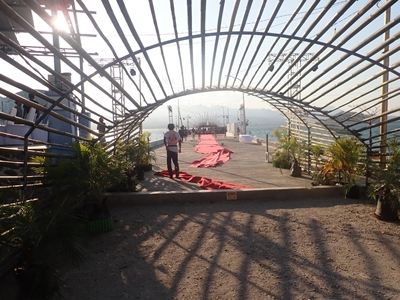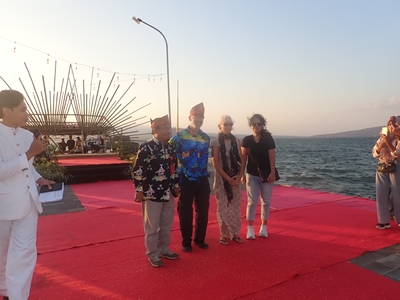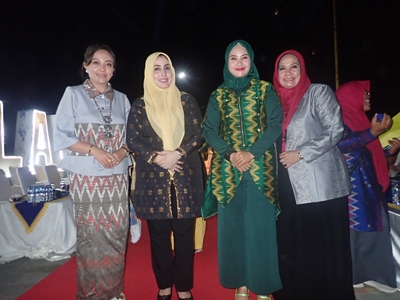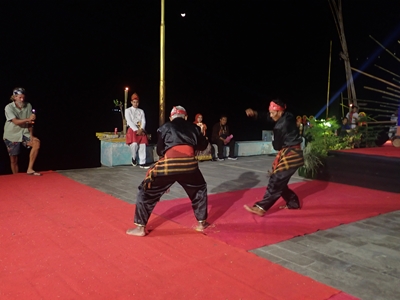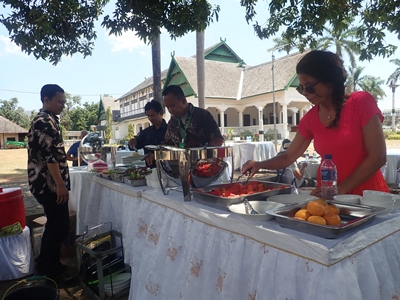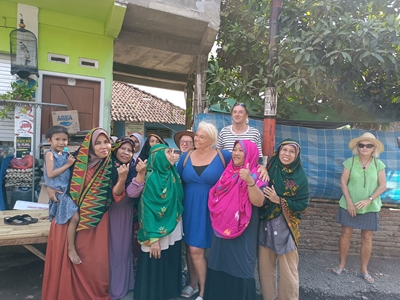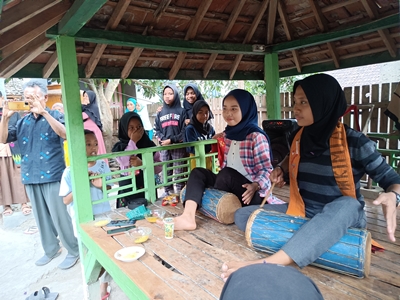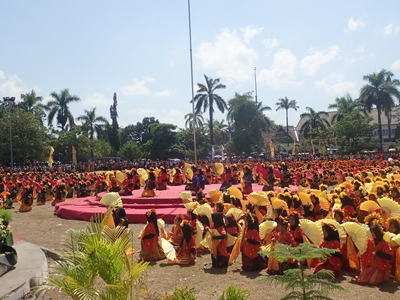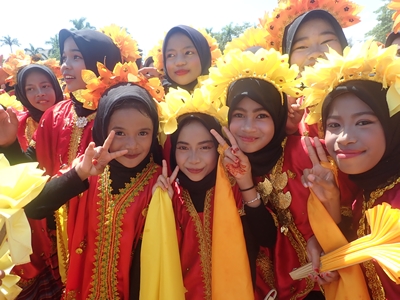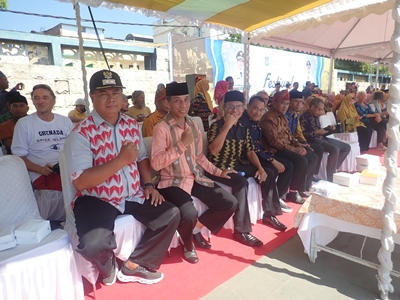Sumbawa Part 1, Bima. 08:28.15S 118:42.9E

The island of Sumbawa lies between Flores to the east and Lombok to the west. It is not much on the tourist track and the two towns we visited, Bima and Badas, would not normally have attracted us but the locals welcomed the rally with the enthusiasm we have become used to and laid on a great programme of events for us. From our last stop on Banta Island it was 48 miles to Bima: a good day’s sail. We left at 0745 which was earlier than Phil wanted, as from the very fragmented tide information we have in Indonesia, it appeared the tide in the channel between Banta and Sumbawa might be against us. It was and, together with a number of other rally boats, we went sideways for a while until it eased from over 4 knots to a more manageable 1.5 knots. It then changed direction total another 4 times before we got to the top of Sumbawa. We then picked up the normal afternoon northerly wind and had a great sail towards Bima, but the delay caused by the tide meant we couldn’t get all the way into the town. Together with Lola B, we anchored for the night at Sapui Beach, about 10 miles outside. Ashore was what appeared to be a small, poor settlement with just a few buffalos grazing in the trees, but one of the shacks on the beach was a karaoke bar and the music boomed out until gone midnight. Just as we had got to sleep our anchor alarm went off. It was such a calm night that we couldn’t believe we had dragged, but we had. We think we must have dropped in some weed which stopped the anchor resetting properly when we swung in the night.
Going sideways. The black line is where we are pointing and the blue line is where we are going. The purple line is the tide.
From the anchorage at Sapui beach we saw a fleet of scores of these local fishing boats, as wide as they are long, going out for the night. When we left Bima a few days later and while it was still dark, they were lining the channel to the town and it was really difficult to tell where they were going. In the morning we motored the final few miles down the bay to the town, to the rally anchorage. The town had put in a dinghy dock for us, sheltered from the swell that picked up most afternoons and were busy preparing the quay for the welcome ceremony. Strong winds were causing them problems and the ceremony was delayed until things calmed down in the evening. The event was in two parts: and informal welcome in the afternoon before a break while the locals attended Friday prayers and the sailors went for something to eat. At the far end of the quay an area had been set aside for us outside one of the bars with bean bag seating overlooking our anchorage. This bar had been given special permission to serve us beer, as the town was otherwise dry. In the evening all the local people were dressed in their finery, rather putting us too shame. The mayor attended and gave a welcome speech and we were entertained with music and dancing.
Preparing the jetty for the welcome ceremony
Phil and Kat (from Muskoka) were selected to receive gifts from the town. A scarf for Kat and a headdress for Phil. Luckily for Phil it was Kat who got to give the Thank You speech on behalf of the visitors!
Dancers
The Mayor’s entrance is preceded by warriors
The Mayor’s wife in the yellow headscarf with her attendants – more of those gorgeous fabrics later
These men gave a stylised display of martial arts. They still ended up grappling with each other and rolling around on the floor and obviously having a great time! The next day a City Tour had been organised. Phil opted out, but Sarah went along. We were loaded into a fleet of cars – we were all allocated to a car – and proceeded to our various destinations in convoy preceded by a police car with flashing blue lights. We drove down the wrong side of the road and jumped red lights more often than is normal here! Its possible that the reason for this is Bima’s historical reputation as a seat of fundamentalist, anti western, terrorism. Our first stop was a village outside town were traditional buildings are still used to store agricultural produce, particularly rice. At one time these buildings were also used as homes, but they are now just for storage.
The rice village. Rice is stored in the top section, accessed by ladder, for up to a year Second stop was the Sultan’s palace, now a museum. There were a few objects of interest, particularly in the gold room, but the crown jewels are in a museum in the Netherlands, and the guide’s English was almost incomprehensible so the visit wasn’t that enlightening. It was interesting to learn that such a poor country produces gold, as well as being a member of OPEC.
We were served lunch in the shade of trees in the museum gardens. The Sultan’s Palace is in the background After lunch we went to see the Sultan’s grave site – a prime spot overlooking Bima Bay with the Sultans buried in state and their wives in ordinary graves outside. Then it was on to the site Sarah was really interested in: the weaving village. We had seen examples of the fabrics they weave in the formal wear of the people attending the welcome ceremony and they were beautiful. The village had apparently never received a tour group before and we were given an overwhelming welcome, with everyone turned out to greet us and hundreds of photos requested. As well as the women weaving outside their houses there were dancing displays, children taking part in traditional games (including marbles and hopscotch) and beautiful fabrics on display everywhere.
We had scarcely got out of our car before this group of women asked me and Lynn to have our photo with them
The women weave sitting on the floor with a wooden bar that forms part of the loom behind their back to hold them in place. It requires a lot of force to push the thread they are working with against the ones already worked
The yarn was also spun in the village
These two girls were playing the drums for the village dancers Given the amount of work involved the price of about 35GBP for a piece 60cm by 4 meters seemed very good value and Sarah came away with two lengths (luckily she didn’t know in advance that they took credit cards or it might have been more). Back at the port Phil came ashore to join the crew for a meal at the Bean Bag Bar. The next day was the big event: the Colossal Dance. This was a regular local event, not something organised specially for the rally, but we were honoured guests again. We were picked up in minibuses this time, and the police escort took us to the park in the centre of town where we were seated on the raised and shaded platform with the town digniatories. Before the mayor’s arrival there were dancing displays by various school groups aged from pre-school upwards. When the mayor arrived we saw the welcome dance we have seen several times performed as it was probably intended. He paused before walking up to his seat and the dancers came forward to welcome him to the event. Once he was seated the Colossal Dance began. There were said to be over 2,000 dancers, who had been waiting around the edges of the park, and they had been practicing for several weeks for the event. It was quite a feat to co-ordinate so many and the overall impact was amazing.
Some of the 2000 dancers waving their fans Once again, our welcome was overwhelming and after the dance was over we had to stand for so many selfies with the dancers and their proud parents. At one point Sarah saw Mitch from Ocean Lady (well over 6ft tall and with blond dreadlocks) surrounded by children giving them high fives. She tried to get close to take a photo but was immediately surrounded herself and got completely stuck.
Photos galore
Mitch
Our neighbours at the event. The women sat at the opposite end of the platform! When the performance was over we told Arif, who was the main organiser for our activities, that we needed to go to the bank and to top up Phil’s phone. He put us in a minibus on our own so we thought our driver was taking us to do our chores while everyone else went back to the boats. No. When we got to the bank we realised that the whole convoy, including police escort was still with us. The policeman even went into the phone shop with Phil, ensuring he got the full attention of the manager! There were more events organised for the next day, but the time allowed to get to the next stop at Badas was short, so we decided to miss them and get on our way |


